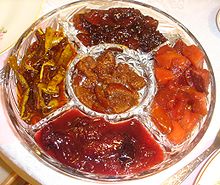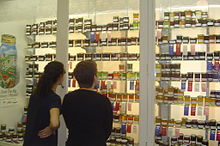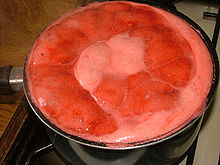- Fruit preserves
-
"Jam" redirects here. For other uses, see Jam (disambiguation).
 Five varieties of fruit preserves (clockwise from top): apple, quince, plum, squash, orange (in the center)
Five varieties of fruit preserves (clockwise from top): apple, quince, plum, squash, orange (in the center)
Fruit preserves are preparations of fruits and sugar, often canned or sealed for long-term storage. The preparation of fruit preserves today often involves adding commercial or natural pectin as a gelling agent, although sugar or honey may be used, as well. Prior to World War II, fruit preserve recipes did not include pectin, and many artisan jams today are made without pectin. The ingredients used and how they are prepared determine the type of preserves; jams, jellies and marmalades are all examples of different styles of fruit preserves that vary based upon the ingredients used.
Many varieties of fruit preserves are made globally, including sweet fruit preserves, such as strawberry, as well as savoury preserves of culinary vegetables, such as tomatoes or squash. In North America, the plural form "preserves" is used to describe all types of jams and jellies. In British and Commonwealth English most fruit preserves are simply called jam, with the singular preserve being applied to high fruit content jam, often for marketing purposes. Additionally, the name of the type of fruit preserves will also vary depending on the regional variant of English being used.
Contents
Variations
Chutney
Main article: ChutneyA chutney is a pungent relish of Indian origin made of fruit, spices and herbs. Although originally intended to be eaten soon after production, modern chutneys are often made to be sold, so require preservatives – often sugar and vinegar – to ensure they have a suitable shelf life. Mango chutney, for example, is mangoes reduced with sugar.
Confit
Main article: ConfitConfit, which is the past participle form of the French verb confire or "to preserve", is most often applied to preservation of meats, especially poultry and pork, by cooking them in their own fat or oils and allowing the fats to set.[1] However, the term can also refer to fruit or vegetables which have been seasoned and cooked with honey or sugar until the mixture has reached a jam-like consistency.[2] Savory confits, such as ones made with garlic or tomatoes, may call for a savory oil, such as virgin olive oil, as the preserving agent.[3][4]
Conserves
A conserve, or whole fruit jam,[5] is a jam made of fruit stewed in sugar.
Often the making of conserves can be trickier than making a standard jam, because the balance between cooking, or sometimes steeping in the hot sugar mixture for just enough time to allow the flavor to be extracted from the fruit,[6] and sugar to penetrate the fruit, and cooking too long that fruit will break down and liquefy. This process can also be achieved by spreading the dry sugar over raw fruit in layers, and leaving for several hours to steep into the fruit, then just heating the resulting mixture only to bring to the setting point.[5][7] As a result of this minimal cooking, some fruits are not particularly suitable for making into conserves, because they require cooking for longer periods to avoid issues such as tough skins.[6] Currants and gooseberries, and a number of plums are among these fruits.
Due to this shorter cooking period, not as much pectin will be released from the fruit, and as such, conserves (particularly home-made conserves) will sometimes be slightly softer set than some jams.[7]
An alternate definition holds that conserves are preserves made from a mixture of fruits and/or vegetables. Conserves may also include dried fruit or nuts.[8]
Fruit butter
Main article: Fruit butterFruit butter, in this context, refers to a process where the whole fruit is forced through a sieve or blended after the heating process.
- "Fruit butters are generally made from larger fruits, such as apples, plums, peaches or grapes. Cook until softened and run through a sieve to give a smooth consistency. After sieving, cook the pulp ... add sugar and cook as rapidly as possible with constant stirring... The finished product should mound up when dropped from a spoon, but should not cut like jelly. Neither should there be any free liquid."—Berolzheimer R (ed) et al. (1959)[9]
Fruit curd
Main article: Fruit curdFruit curd is a dessert topping and spread usually made with lemon, lime, orange, or raspberry.[10] The basic ingredients are beaten egg yolks, sugar, fruit juice and zest which are gently cooked together until thick and then allowed to cool, forming a soft, smooth, intensely flavored spread. Some recipes also include egg whites and/or butter.[11]
Fruit spread
Fruit spread refers to a jam or preserve with no added sugar.
Jam
Jam contains both fruit juice and pieces of the fruit's (or vegetable's) flesh,[12] although some cookbooks define jam as cooked and gelled fruit (or vegetable) purees.[13]
Properly, the term "jam" refers to a product made with whole fruit, cut into pieces or crushed. The fruit is heated with water and sugar to activate the pectin in the fruit. The mixture is then put into containers. The following extract from a US cookbook describes the process.
- "Jams are usually made from pulp and juice of one fruit, rather than a combination of several fruits. Berries and other small fruits are most frequently used, though larger fruits such as apricots, peaches, or plums cut into small pieces or crushed are also used for jams. Good jam has a soft even consistency without distinct pieces of fruit, a bright color, a good fruit flavor and a semi-jellied texture that is easy to spread but has no free liquid." – Berolzheimer R (ed) et al. (1959)[notes 1]
Examples:
- Peach Blackberry jam (Sweet,fruit)
- Strawberry jam (sweet, fruit)
Variations
Uncooked or minimally cooked (less than 5 minutes) jams, called freezer jam, because they are stored frozen, are popular in parts of North America for their very fresh taste.
Jelly
Jelly is a clear or translucent fruit spread made from sweetened fruit (or vegetable) juice and set using naturally occurring pectin. Additional pectin may be added where the original fruit does not supply enough, for example with grapes.[12] Jelly can be made from sweet, savory or hot ingredients. It is made by a process similar to that used for making jam, with the additional step of filtering out the fruit pulp after the initial heating. A muslin or stockinette "jelly bag" is traditionally used as a filter, suspended by string over a bowl to allow the straining to occur gently under gravity. It is important not to attempt to force the straining process, for example by squeezing the mass of fruit in the muslin, or the clarity of the resulting jelly will be compromised.
- "Good jelly is clear and sparkling and has a fresh flavor of the fruit from which it is made. It is tender enough to quiver when moved, but holds angles when cut.
- EXTRACTING JUICE — Pectin is best extracted from the fruit by heat, therefore cook the fruit until soft before straining to obtain the juice ... Pour cooked fruit into a jelly bag which has been wrung out of cold water. Hang up and let drain. When dripping has ceased the bag may be squeezed to remove remaining juice, but this may cause cloudy jelly." – Berolzheimer R (ed) et al. (1959)[notes 2]
Examples:
Marmalade
Main article: MarmaladeBritish-style marmalade is a sweet preserve with a bitter tang made from fruit, sugar, water, and (in some commercial brands) a gelling agent. American-style marmalade is sweet, not bitter. In English-speaking usage, marmalade almost always refers to a preserve derived from a citrus fruit, most commonly oranges, although onion marmalade is also used as an accompaniment to savory dishes.
The recipe includes sliced or chopped fruit peel, which is simmered in fruit juice and water until soft; indeed, marmalade is sometimes described as jam with fruit peel (although many companies now also manufacture peel-free marmalade). Such marmalade is most often consumed on toasted bread for breakfast. The favored citrus fruit for marmalade production in the UK is the Seville orange, Citrus aurantium var. aurantium, thus called because it was originally imported from Seville in Spain; it is higher in pectin than sweet oranges, and therefore gives a good set. Marmalade can also be made from lemons, limes, grapefruit, strawberries or a combination.
Regional terminology
 Jams, jellies and honeys, Minnesota State Fair
Jams, jellies and honeys, Minnesota State Fair
The term preserves is usually interchangeable with jam. Some cookbooks define preserves as cooked and gelled whole fruit (or vegetable), which includes a significant portion of the fruit.[13]
The terms jam and jelly are used in different parts of the English-speaking world in different ways. In the United States, both jam and jelly are sometimes popularly referred to as "jelly", whereas in the United Kingdom, Canada, India and Australia, the two terms are more strictly differentiated. In Australia and South Africa, the term "jam" is more popularly used as a generic term for both jam and jelly.[14][15]
To further confuse the issue, the term "jelly" is also used in the UK, South Africa, Australia, India and New Zealand to refer to a gelatin dessert, known in North America as jello, derived from the brand name Jell-O.
Production
In general, jam is produced by taking mashed or chopped fruit or vegetable pulp and boiling it with sugar and water. The proportion of sugar and fruit varies according to the type of fruit and its ripeness, but a rough starting point is equal weights of each. When the mixture reaches a temperature of 104 °C (219 °F),[citation needed] the acid and the pectin in the fruit react with the sugar, and the jam will set on cooling. However, most cooks work by trial and error, bringing the mixture to a "fast rolling boil", watching to see if the seething mass changes texture, and dropping small samples on a plate to see if they run or set.[16]
Commercially produced jams are usually produced using one of two methods. The first is the open pan method, which is essentially a larger scale version of the method a home jam maker would use. This gives a traditional flavor, with some caramelization of the sugars. The second commercial process involves the use of a vacuum vessel, where the jam is placed under a vacuum, which has the effect of reducing its boiling temperature to anywhere between 65 and 80 °C depending on the recipe and the end result desired. The lower boiling temperature enables the water to be driven off as it would be when using the traditional open pan method, but with the added benefit of retaining more of the volatile flavor compounds from the fruit, preventing caramelization of the sugars, and of course reducing the overall energy required to make the product. However, once the desired amount of water has been driven off, the jam still needs to be heated briefly to 95 to 100 °C to kill off any micro-organisms that may be present; the vacuum pan method does not kill them all. During the commercial filling of the jam into jars, it is common to use a flame to sterilize the rim of the jar and the lid to destroy any yeasts and molds which may cause spoilage during storage. It is also common practice to inject steam into the head space at the top of the jar immediately prior to the fitting of the lid, to create a vacuum. Not only does this vacuum help prevent the growth of spoilage organisms, but it also pulls down the tamper-evident safety button when lids of this type are employed.
Packaging
Jam jars are an efficient method of storing and preserving jam. Though sugar can keep for exceedingly long times, containing it in a jar is far more useful than older methods. Other methods of packaging jam, especially for industrially produced products, include cans, and plastic packets, especially used in the food service industry for indivdiual servings.
Legal definitions
US FDA definitions
The U.S. Food and Drug Administration (FDA) published standards of identity in 21 CFR 150, and treats jam and preserves as synonymous, but distinguishes jelly from jams and preserves. All of these are cooked and pectin-gelled fruit products, but jellies are based entirely on fruit juice or other liquids, while jams and preserves are gelled fruit that may include the seeds and pulp. The United States Department of Agriculture offers grading service based on these standards.[12]
Canadian regulations
Under the Processed Products Regulations (C.R.C., c. 291), jams, jellies, citrus marmalade and preserves are defined. Each must contain a minimum percentage of the named fruit and a minimum percentage of water-soluble solids. Jams "shall be the product made by boiling fruit, fruit pulp or canned fruit to a suitable consistency with water and a sweetening ingredient", jellies "shall be the product made by boiling fruit juice or concentrated fruit juice that is free from seeds and pulp with water and a sweetening ingredient until it acquires a gelatinous consistency."[17]
European Union directives on jam
In the European Union, the jam directive (Council Directive 79/693/EEC, 24 July 1979)[18] set minimum standards for the amount of "fruit" in jam, but the definition of fruit was expanded to take account of several unusual kinds of jam made in the EU. For this purpose, "fruit" is considered to include fruits that are not usually treated in a culinary sense as fruits, such as tomatoes, cucumbers, and pumpkins; fruits that are not normally made into jams; and vegetables that are sometimes made into jams, such as: rhubarb (the edible part of the stalks), carrots, and sweet potatoes. This definition continues to apply in the new directive, Council Directive 2001/113/EC of 20 December 2001 relating to fruit jams, jellies and marmalades and sweetened chestnut purée intended for human consumption.[19]
Extra jam is subject to somewhat stricter rules that set higher standards for the minimum fruit content (45% instead of 35% as a general rule, but lower for some fruits such as redcurrants and blackcurrants), as well specifying as the use of unconcentrated fruit pulp, and forbidding the mixture of certain fruits and vegetables with others.[19]
Jelly worldwide
- Almond jelly, a sweet dessert from Hong Kong
- Coffee jelly features in many desserts in Japan.
- Jellied cranberry sauce is primarily a holiday treat in the U.S. and the UK.
- Grass jelly, a food from China and Southeast Asia, often served in drinks
- Konjac, a variety of Japanese jelly made from konnyaku
- Mayhaw jelly is a delicacy in parts of the American South.
- Muk, a variety of Korean jelly, seasoned and eaten as a cold salad
- Nata de coco, jelly made from coconuts originating from the Philippines
- Yōkan, a sweet, pasty jelly dessert from Japan often made with beans, sweet potato or squash
There are a variety of jellies in the cuisines of East and Southeast Asia. Depending on the type, they may be sweet or unsweetened.
See also
Notes
References
- ^ "On the menu: confit". The Guardian. UK. 29 September 2008. http://www.guardian.co.uk/theguardian/2000/sep/29/features11.g22. Retrieved 20 September 2008. "Usually duck, pork or goose, although you can use other meats."
- ^ "Definition: Confit". American Heritage Dictionary. Dictionary.com. http://dictionary.reference.com/browse/confit. Retrieved 20 September 2008. "A condiment made by cooking seasoned fruit or vegetables!, usually to a jamlike consistency"
- ^ "Tomato Confit recipe". Bon Appétit. Epicurious. September 2003. http://www.epicurious.com/recipes/food/views/TOMATO-CONFIT-AND-MARINATED-TOMATOES-SERVED-ON-A-CRISPY-TART-108547. Retrieved 20 September 2008.
- ^ "Garlic Confit recipe". Bon Appétit. Epicurious. January 2008. http://www.epicurious.com/recipes/food/views/GARLIC-CONFIT-241125. Retrieved 20 September 2008. "Can be made 1 month ahead. Keep chilled and completely covered in oil. Always use clean spoon to remove garlic."
- ^ a b Grange, Cyril (1992) (in En). The Right Way To Make Jams (2nd ed.). Right Way Books. ISBN 0716021269.
- ^ a b Patten, Marguerite (February 2001) (in En). Basic Basics: Jams, Preserves and Chutneys Handbook (2004 reprint ed.). Grub Street Books. ISBN 1902304721.
- ^ a b Thomas, Midge (2 September 2002). Best kept secrets of the Women's Institute: Jams, pickles & chutneys (1st ed.). Simon & Schuster. ISBN 0743221133.
- ^ Isabel D. Wolf; William Schafer (1990). "Making Jams, Marmalades, Preserves, and Conserves". University of Minnesota extension school. http://www.extension.umn.edu/distribution/nutrition/DJ1088.html. Retrieved 20 September 2008.
- ^ Ruth Berolzheimer (ed) et al. (1969). Culinary arts institute encyclopedic cookbook (revised),. Chicago USA.: Culinary arts institute. p. 830. ASIN B000N4WC5Y.
- ^ "Cake Talk: What the terms mean". The Joy of Cooking. The Seattle Times. 29 June 2005. http://community.seattletimes.nwsource.com/archive/?date=20050629&slug=caketerms29. Retrieved 2 September 2008.
- ^ Gordon Ramsay (20 June 2007). "Lemon and Poppy Seed Scones with Homemade Lemon Curd". The Times (UK).
- ^ a b c "Grading Manual for Fruit Jelly Fruit Preserves" (PDF). http://www.ams.usda.gov/fv/ppbweb/manuals/jelly.pdf.
- ^ a b The Joy of Cooking. 1975.
- ^ Howard L & Patten M (eds), 1960, The Australian Women's Weekly — Cookery in colour, Paul Hamlin LTD, London UK, sections956-971
- ^ "en.wikipedia.org/wiki/List_of_lexical_differences_in_South_African_English#F-J". http://en.wikipedia.org/wiki/List_of_lexical_differences_in_South_African_English#F-J.
- ^ Ball Blue Book of Preserving, Alltrista Consumer Products, June, 2004 ISBN 0972753702 ISBN 978-0972753708
- ^ http://laws-lois.justice.gc.ca/eng/regulations/C.R.C.,_c._291/page-21.html?term=jams+jam#sched2
- ^ Council Directive 79/693/EEC of 24 July 1979 on the approximation of the laws of the Member States relating to fruit jams, jellies and marmalades and chestnut purée. Not in force, replaced by Directive 2001/113/EC.
- ^ a b "Council Directive 2001/113/EC of 20 December 2001 relating to fruit jams, jellies and marmalades and sweetened chestnut purée intended for human consumption". http://eur-lex.europa.eu/LexUriServ/LexUriServ.do?uri=CELEX:32001L0113:EN:NOT.
External links
Categories:- Condiments
- Food ingredients
- Gels
- Spreads
- Food preservation
Wikimedia Foundation. 2010.


